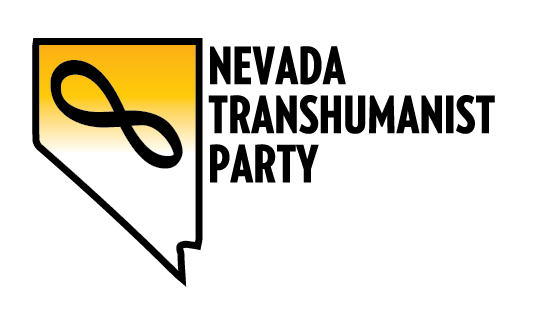Nevada Transhumanist Party Positions on 2018 Nevada Ballot Questions

The Nevada Transhumanist Party offers the following brief statements of position on the ballot questions currently before Nevada voters in the 2018 General Election.
Summary
Question 1: Support
Question 2: Support
Question 3: Support
Question 4: Support
Question 5: Oppose
Question 6: Oppose
Ballot Question 1 – Marsy’s Law Crime Victims’ Rights Amendment – Support
Wording of Ballot Question: “Shall the Nevada Constitution be amended to: (1) remove existing provisions that require the Legislature to provide certain statutory rights for crime victims; and (2) adopt in their place certain expressly stated constitutional rights that crime victims may assert throughout the criminal or juvenile justice process?” (More information on BallotPedia.)
Position of the Nevada Transhumanist Party: The Nevada Transhumanist Party supports Ballot Question 1 as an expansion of the rights of crime victims to render those rights more symmetrical to the protections that those accused of criminal acts already receive. The Nevada Transhumanist Party strongly holds that due process is vital for both the accused and the victim of a crime. Section X of the Nevada Transhumanist Party Platform states, in part, that “each individual should be sentenced based solely on the consideration of the nature of that individual’s crime, its context, and its severity.” However, the nature, context, and severity of a crime can only be ascertained if victims are permitted to participate in the justice process, with full protections of their safety and right to be heard. One of the most important protections of Ballot Question 1 is “To have all monetary payments, money and property collected from any person who has been ordered to make restitution be first applied to pay the amounts ordered as restitution to the victim.” This shifts the focus of the justice system toward compensating the victim, instead of simply enriching the state. A restitution-oriented justice system is ideal where the damage from a crime can be repaired or compensated monetarily, as this approach actually endeavors to make the victims whole and thereby undo as many of the ill effects of the crime as possible. The more lives can be repaired in this way, the fewer obstacles to innocent individuals’ flourishing will exist, and the faster our society will progress in economic, moral, and technological dimensions.
Ballot Question 2 – Sales-Tax Exemption for Feminine Hygiene Products – Support
Wording of Ballot Question: “Shall the Sales and Use Tax Act of 1955 be amended to provide an exemption from the taxes imposed by this Act on the gross receipts from the sale and the storage, use or other consumption of feminine hygiene products?” (More information on BallotPedia.)
Position of the Nevada Transhumanist Party: The Nevada Transhumanist Party supports Ballot Question 2 as a protection for the morphological freedom of individuals. The morphological freedom of female individuals is infringed by asymmetrical taxation of products that those individuals uniquely require. While the Nevada Transhumanist Party does not oppose sales taxes per se, exemptions from sales taxes for the necessities of life are reasonable if such taxes pose impediments to individual quality of life or even the ability to afford those necessities.
Ballot Question 3 – Energy Choice Initiative – Support
Wording of Ballot Question: “Shall Article 1 of the Nevada Constitution be amended to require the Legislature to provide by law for the establishment of an open, competitive retail electric energy market that prohibits the granting of monopolies and exclusive franchises for the generation of electricity?” (More information on BallotPedia.)
Position of the Nevada Transhumanist Party: The Nevada Transhumanist Party supports Ballot Question 3 to eliminate the coercive energy monopoly currently held by NV Energy and allow individuals to choose their utility and source of energy, much like they are able to choose which furniture or which cars to buy today. NV Energy has used its monopoly position to stifle and penalize the deployment of economical rooftop solar systems, which allow homeowners to autonomously generate their own electricity and even earn some money doing so. The suppression of such opportunities is a travesty of justice and needs to be reversed.
The NV Energy monopoly is not only harmful to technological progress, renewal energy, and affordable electricity costs; it is also a danger to the health and safety of homeowners. This is because of NV Energy’s arcane, deliberately circular call-center system, which gives consumers “the runaround” when consumers attempt to contact NV Energy to request emergency service related to failures in the electrical panels on their homes. NV Energy has connected the main circuit-breakers on many such panels to its “smart meters”, which require the intervention of an NV Energy technician to disable to that the circuit-breakers can be worked on and repaired or replaced. However, NV Energy does not offer consumers a dedicated emergency response to promptly allow access to those consumers’ own electrical systems in situations where hours and even minutes matter for preserving life and property.
The Nevada Transhumanist Party considers particularly reprehensible the “No on 3” campaign in Nevada – orchestrated and almost exclusively (99.99%) financed by NV Energy and its connected organizations – which has been disingenuous in its messaging and which has created many mistaken impressions on the part of the public. Question 3 would only deprive NV Energy of its monopoly powers; it would not mirror the California-style (pseudo)-“deregulation” of the late 1990s, nor would it thwart any renewable-energy projects. Quite the contrary, it has been NV Energy and only NV Energy that has stifled efforts by consumers and rooftop-solar installers to create genuine alternatives to NV Energy’s electrical grid and its intentionally cumbersome and restrictive policies.
Question 3, indeed, would require that the Nevada Legislature “ensure that protections are established that entitle customers to safe, reliable, and competitively priced electricity;” and “protect against service disconnections and unfair practices” – protections that are currently absent because of the NV Energy monopoly’s political connections, asymmetrical lobbying clout, and the regulatory capture of the Public Utilities Commission.
Nevada’s voters overwhelmingly approved Question 3 in 2016 (72.36% voted in favor). Now that NV Energy has launched a last-ditch campaign in reaction to the jeopardy in which its monopoly finds itself, voters should inform themselves and see through the misleading rhetoric of the “Coalition to Defeat Question 3” (i.e., NV Energy). The Nevada Transhumanist Party staunchly supports Question 3 as the pathway toward major technological progress and innovation in the realm of energy, harnessing the forces of market competition to provide cleaner, more affordable electricity for all Nevadans.
Ballot Question 4 – Medical Equipment Sales Tax Exemption Amendment – Support
Wording of Ballot Question: “Shall Article 10 of the Nevada Constitution be amended to require the Legislature to provide by law for the exemption of durable medical equipment, oxygen delivery equipment, and mobility enhancing equipment prescribed for use by a licensed health care provider from any tax upon the sale, storage, use, or consumption of tangible personal property?” (More information on BallotPedia.)
Position of the Nevada Transhumanist Party: The Nevada Transhumanist Party supports Ballot Question 4 to exempt durable medical equipment from sales and use tax. These taxes can often run into the thousands of dollars for sick and dying patients and could compromise the quality of their care. We support any measure that helps make medical equipment affordable and more widespread.
Ballot Question 5 – Automatic Voter Registration via DMV – Oppose
Wording of Ballot Question: “Shall Chapter 293 of the Nevada Revised Statutes be amended to establish a system that will automatically register an eligible person to vote, or update that person’s existing Nevada voter registration information, at the time the person applies to the Nevada Department of Motor Vehicles for the issuance or renewal of any type of driver’s license or identification card, or makes a request to change the address on such a license or identification card, unless the person affirmatively declines in writing?” (More information on BallotPedia.)
Position of the Nevada Transhumanist Party: The Nevada Transhumanist Party opposes Ballot Question 5. While the Nevada Transhumanist Party supports efforts to render voter registration easy and seamless, the particular requirements of Ballot Question 5 would entail the DMV being mandated to insert disclosures that encourage voters to select a major political-party registration by including a statement “that the person will not be able to vote at a primary election for candidates for partisan offices of a major political party unless the person indicates a major political party affiliation”. Such wording – which would essentially compel a State agency to advertise for the major political parties – would further skew the political arena toward the major political parties and would entrench their dominance. Voter registration should furthermore always occur on an opt-in, rather than opt-out, basis; this is the only approach that consistently respects individual autonomy and choice to participate in the political system or to abstain from such participation. Opting in should be easy and made available through a variety of methods (including electronic, same-day registration), but the presumption of registration can create logistical difficulties for some individuals and conceivable situations where an automatic “updated” registration generates needless contradictions in a person’s registration status, which would actually render it more difficult for that person to subsequently cast a vote.
Ballot Question 6 – Renewable Energy Standards Initiative – Oppose
Wording of Ballot Question: “Shall Article 4 of the Nevada Constitution be amended to require, beginning in calendar year 2022, that all providers of electric utility services who sell electricity to retail customers for consumption in Nevada generate or acquire incrementally larger percentages of electricity from renewable energy resources so that by calendar year 2030 not less than 50 percent of the total amount of electricity sold by each provider to its retail customers in Nevada comes from renewable energy resources?“ (More information on BallotPedia.)
Position of the Nevada Transhumanist Party: The Nevada Transhumanist Party opposes Ballot Question 6. While the Nevada Transhumanist Party supports economical renewable energy and the acceleration of efforts to develop technologies to render as much of our energy supply renewable as possible, the ability to affordably generate 50 percent of the total electricity through renewable energy resources is ultimately a technological challenge, not a political one. If the technology is ready, and the market is robust and competitive enough to deploy it to consumers at more attractive prices than fossil-fuel energy, then a 50-percent or greater renewable proportion of electricity will be achieved by 2030 without the need for a mandate. If, however, the technology cannot yet render renewable energy competitive with fossil fuels, then the only effect of the mandate would be to push up costs and constrict supply of electricity to consumers. The surest way to bring about a future of greater renewable energy is to repeal the NV Energy monopoly which has been standing in its way. Through competition, both technological and marketing innovations will thrive and will deliver renewable energy solutions to consumers. Ballot Question 3, rather than Ballot Question 6, is therefore a superior means toward that goal.


